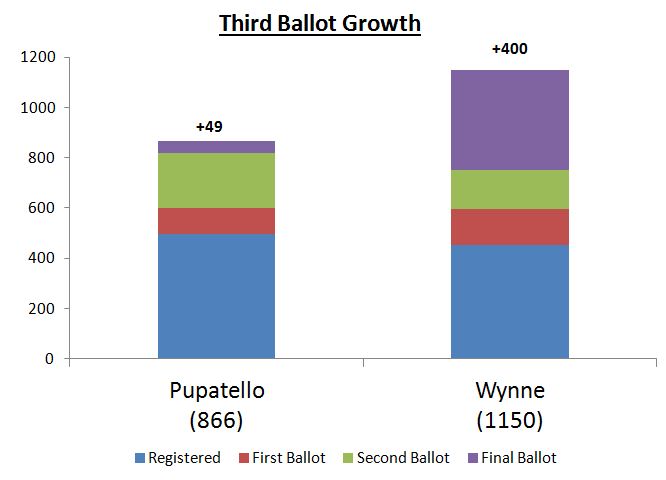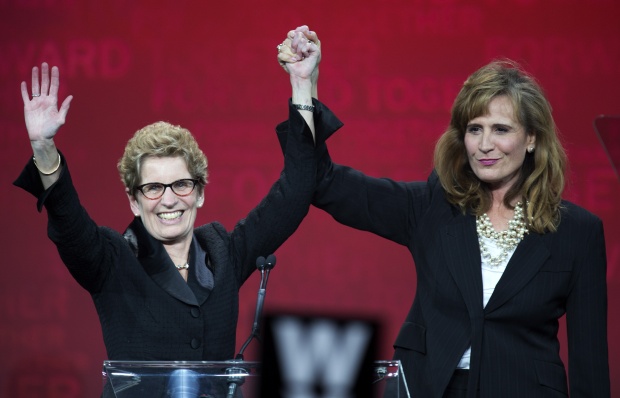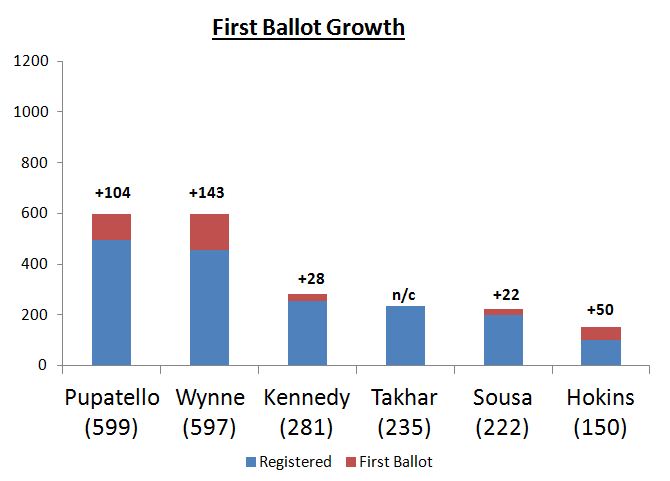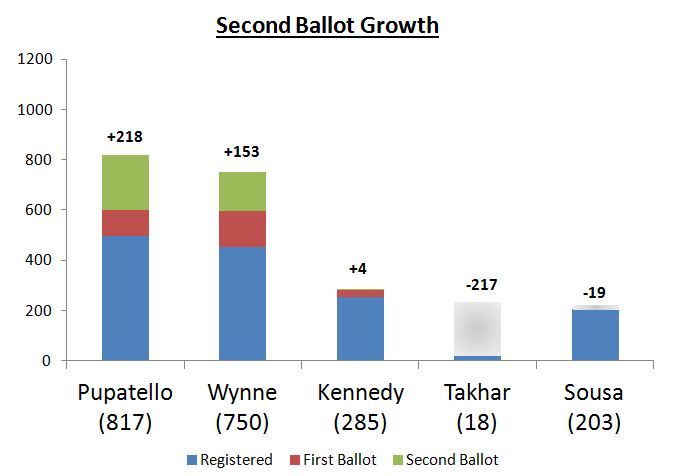On Saturday, Maple Leaf Gardens was a cauldron of emotions. There were tears, broken promises, dashed dreams, and shrieks of pure unadulterated joy. That’s to be expected when you bring 2,000 people with very different motivations and beliefs together, and ask them to figure out who will govern a province of over 12 million people.
Yet despite all of that, in the end, what mattered more than the signs and scarves and speeches were the cold hard numbers. So it’s worth pausing to study the math behind Kathleen Wynne’s historic victory:
The First Ballot
The big story of the first ballot was Wynne’s jump to within 2 votes of Pupatello. To get a sense of where that support came from, it’s important to not look at the number of delegates elected but at the number who were actually registered at the convention and eligible to vote after backfills, alternate bumps, and no-shows are taken into account:
| Pupatello | 495 |
| Wynne | 454 |
| Kennedy | 253 |
| Takhar | 235 |
| Sousa | 200 |
| Hoskins | 100 |
There were also 67 registered independents and 320 registered ex-officios. Here’s how they broke in round one:
That means 40 delegates either didn’t vote or ate their ballots – including at least one Takhar delegate, unless Harrinder forgot to vote for himself.
The real story of this was Wynne picking up over 40% of the uncommitted voters. Pre-convention reports had her 10-15 behind Pupatello in the ex-officio count, so it seems likely she was able to snag most of the independent voters – and I guess that shouldn’t be too surprising, given many of them were former Glen Murray supporters.
Until we read the tell-all memoirs in 20 years, we won’t know for sure what was going through each candidate’s head at this point, but Wynne’s bounce certainly shifted the odds in her favour, perhaps prompting Hoskins to also shift his endorsement. It also meant the path to a Kennedy victory now relied on more aggresive math – with Hoskins moving to Wynne, Kennedy would have needed at least three-quarters of Takhar and Sousa’s delegates to reach the final ballot. This likely killed any talk of a third option, explaining Takhar’s bizarre move to Pupatello after the deadline to withdraw.
The Second Ballot
With the race now clearly a two-woman show, Kennedy was only able to grow by 4 delegates, and Sousa fell by 19. While no candidate is ever able to deliver 100% of their delegates, both the numbers and what I saw on the floor suggest that’s almost exactly what happened. Pupatello’s vote jumped by 218 – toss in the 18 confused Takhar delegates who voted for their unofficially withdrawn leader, and you nearly hit Takhar’s first ballot number on the money. Similarly, Wynne’s gain of 153 was nearly spot-on to Hoskins’ first ballot total (though some high profile Hoskins supporters did go to Pupatello, including the Right Honourable John Turner).
While Kennedy and Sousa could have stayed around and pushed the inevitable back to midnight, both recognized the reality of the situation and withdrew. A Sousa-to-Pupatello and Kennedy-to-Wynne scenario would have set up an interesting final ballot, but it does not appear that either candidate nor their supporters had much appetite to back Pupatello, whose team had spent much of the campaign belitleling them.
Both men marched to Wynne, effectively sealing the deal. Unless the protestors outside burned the building to the ground, the math was now such that there was virtually no way for Pupatello to hold her lead.
The Third Ballot
As Jeff Jedras reports, some delegates decided it wasn’t worth waiting for the burst water pipes to be fixed and called it a day. Still, all but 57 stayed and voted:

Together, Kennedy and Sousa moved 89% of their vote to Wynne on the final ballot – remarkable when you consider the historical norms, but likely in line with what Takhar and Hoskins also delivered.
Perhaps the timid nature of the campaign left most delegates without strong feelings towards either of the frontrunners, so they figured they might as well follow their man. Perhaps the short timeline gave candidates little time to woo delegates for second ballot support. Perhaps the four defeated candidates all commanded an unusually high sense of loyalty from their troops.
Whatever the reason, this convention came down to cold, hard, delegate math. And the math worked for Wynne a lot better than it did for Pupatello.



3 responses to “Convention Math”
Nice analysis. Your warning about charts was (I guess) prudent but this is about as straight-forward as it gets. Anyone who can’t or won’t follow this really is an arithmophobe.
I think under the “First Ballot” you gave GK 200 more delegates than he actually earned. Feel free to edit this comment after the correction is made. Or call me out on why I’m wrong, haha.
I’m also really intrigued at how faithful the delegates were. Another possibility is that Wynne handily won the race-for-second-place in the minds of nearly all delegates, and that only Takhar’s delegates were REALLY faithful, as would make sense among the community he represented — this was the first time an Indo-Canadian had really made any noise in a leadership contest in Canada (outside of BC) and they may have felt the need to dance with the one that brought them. (I also note Pupatello did horrendous in a lot of the Mississauga/Brampton-area ridings where Takhar has most of his support — perhaps a number of them would have gone to Pupes if Takhar wasn’t in the race.)
Sousa going to Wynne made sense to try and get Hazel’s support for a run at Mississauga mayor, perhaps against Crombie.
I’m also intrigued by this TorStar piece about how Hoskins basically told Pupes she had his support, and then obviously changed his mind by the convention. Pupes is being a good sport about it publicly but she seems like a pretty intense person and must be quietly furious.
I felt like this race was an especially good test of what was more important to me: go with the candidate that best represents my values and being ready to die by the sword of my beliefs (Wynne), or swallow Pupes as the best way of keeping the Tories and NDP out of office. I was pretty comfortable with Wynne from day one but I had quiet concerns. But then I realized that Pupes would have to win a seat in (probably) union-friendly Windsor in the middle of a trough for the OLP and soon after a recent NDP by-election win… hrm… and this led me to think Pupes actually wasn’t any more likely to result in an OLP win in a general election, and all my doubts were washed away.
I think under the “First Ballot” you gave GK 200 more delegates than he actually earned. Feel free to edit this comment after the correction is made. Or call me out on why I’m wrong, haha.
Ha. I guess that was wishful thinking on my part.
Good point about Wynne having solidified herself as the second choice for most. From what I saw of the Kennedy delegates, my guess is if Gerard had endorsed Pupatello, he wouldn’t have been able to move more than 50-60% with him. Sousa might have been able to bring more her way, but who really knows.
Losing their own seat is not as harmful for a leader as you’d think. Mackenzie-King managed to lose his three times, and is our winningest PM.
George Drew did leave office after losing in High Park, but he could have easily re-entered by taking a safe seat. Instead he opted for the federal PC leadership.
True, John Tory’s lack of a seat harmed his leadership. But he managed to stay leader for a year-and-a-half, and it took blowing an easy by-election (lost due to internal dissent against his leadership).